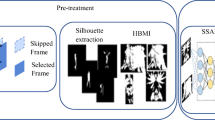Abstract
The effective processing of visual data without interruption is currently of supreme importance. For that purpose, the analysis system must adapt to events that may affect the data quality and maintain its performance level over time. A methodology for background modeling and foreground detection, whose main characteristic is its robustness against stationary noise, is presented in the paper. The system is based on a stacked denoising autoencoder which extracts a set of significant features for each patch of several shifted tilings of the video frame. A probabilistic model for each patch is learned. The distinct patches which include a particular pixel are considered for that pixel classification. The experiments show that classical methods existing in the literature experience drastic performance drops when noise is present in the video sequences, whereas the proposed one seems to be slightly affected. This fact corroborates the idea of robustness of our proposal, in addition to its usefulness for the processing and analysis of continuous data during uninterrupted periods of time.
Access this chapter
Tax calculation will be finalised at checkout
Purchases are for personal use only
Similar content being viewed by others
References
Baldi, P., Hornik, K.: Neural networks and principal component analysis: learning from examples without local minima. Neural Netw. 2(1), 53–58 (1989)
Elgammal, A., Harwood, D., Davis, L.: Non-parametric model for background subtraction. In: Vernon, D. (ed.) ECCV 2000. LNCS, vol. 1843, pp. 751–767. Springer, Heidelberg (2000). https://doi.org/10.1007/3-540-45053-X_48
López-Rubio, E., Luque-Baena, R., Domínguez, E.: Foreground detection in video sequences with probabilistic self-organizing maps. Int. J. Neural Syst. 21(3), 225–246 (2011)
López-Rubio, E., Molina-Cabello, M.A., Luque-Baena, R.M., Domínguez, E.: Foreground detection by competitive learning for varying input distributions. Int. J. Neural Syst. 28(05), 1750056 (2018). https://doi.org/10.1142/S0129065717500563
Maddalena, L., Petrosino, A.: A self-organizing approach to background subtraction for visual surveillance applications. IEEE Trans. Image Process. 17(7), 1168–1177 (2008)
Maddalena, L., Petrosino, A.: The SOBS algorithm: what are the limits? pp. 21–26, June 2012
Robbins, H., Monro, S.: A stochastic approximation method. Ann. Math. Stat. 22(3), 400–407 (1951)
Sobral, A., Bouwmans, T.: BGS library: a library framework for algorithm’s evaluation in foreground/background segmentation. In: Background Modeling and Foreground Detection for Video Surveillance. CRC Press, Taylor and Francis (2014)
St-Charles, P., Bilodeau, G., Bergevin, R.: SuBSENSE: a universal change detection method with local adaptive sensitivity. IEEE Trans. Image Process. 24(1), 359–373 (2015). https://doi.org/10.1109/TIP.2014.2378053
Stauffer, C., Grimson, W.: Adaptive background mixture models for real-time tracking, vol. 2, pp. 246–252 (1999)
Torralba, A., Fergus, R., Freeman, W.: 80 million tiny images: a large data set for nonparametric object and scene recognition. IEEE Trans. Pattern Anal. Mach. Intell. 30(11), 1958–1970 (2008)
Vincent, P., Larochelle, H., Lajoie, I., Bengio, Y., Manzagol, P.: Stacked denoising autoencoders: learning useful representations in a deep network with a local denoising criterion. J. Mach. Learn. Res. 11, 3371–3408 (2010)
Wang, N., Yeung, D.: Learning a deep compact image representation for visual tracking. In: Advances in Neural Information Processing Systems 26, pp. 809–817 (2013)
Wren, C., Azarbayejani, A., Darrell, T., Pentl, A.: Pfinder: real-time tracking of the human body. IEEE Trans. Pattern Anal. Mach. Intell. 19(7), 780–785 (1997)
Zhang, Y., Li, X., Zhang, Z., Wu, F., Zhao, L.: Deep learning driven blockwise moving object detection with binary scene modeling. Neurocomputing 168, 454–463 (2015)
Zivkovic, Z., van der Heijden, F.: Efficient adaptive density estimation per image pixel for the task of background subtraction. Pattern Recognit. Lett. 27(7), 773–780 (2006)
Acknowledgements
This work is partially supported by the Ministry of Economy and Competitiveness of Spain under grant TIN2014-53465-R, project name Video surveillance by active search of anomalous events, besides for the projects with codes TIN2016-75097-P and PPIT.UMA.B1.2017. It is also partially supported by the Autonomous Government of Andalusia (Spain) under grant TIC-657, project name Self-organizing systems and robust estimators for video surveillance. All of them include funds from the European Regional Development Fund (ERDF). The authors thankfully acknowledge the computer resources, technical expertise and assistance provided by the SCBI (Supercomputing and Bioinformatics) center of the University of Málaga. They also gratefully acknowledge the support of NVIDIA Corporation with the donation of two Titan X GPUs used for this research. The authors would like to thank the grant of the Universidad de Malaga.
Author information
Authors and Affiliations
Corresponding author
Editor information
Editors and Affiliations
Rights and permissions
Copyright information
© 2019 Springer Nature Switzerland AG
About this paper
Cite this paper
García-González, J., Ortiz-de-Lazcano-Lobato, J.M., Luque-Baena, R.M., López-Rubio, E. (2019). Background Modeling by Shifted Tilings of Stacked Denoising Autoencoders. In: Ferrández Vicente, J., Álvarez-Sánchez, J., de la Paz López, F., Toledo Moreo, J., Adeli, H. (eds) From Bioinspired Systems and Biomedical Applications to Machine Learning. IWINAC 2019. Lecture Notes in Computer Science(), vol 11487. Springer, Cham. https://doi.org/10.1007/978-3-030-19651-6_30
Download citation
DOI: https://doi.org/10.1007/978-3-030-19651-6_30
Published:
Publisher Name: Springer, Cham
Print ISBN: 978-3-030-19650-9
Online ISBN: 978-3-030-19651-6
eBook Packages: Computer ScienceComputer Science (R0)




